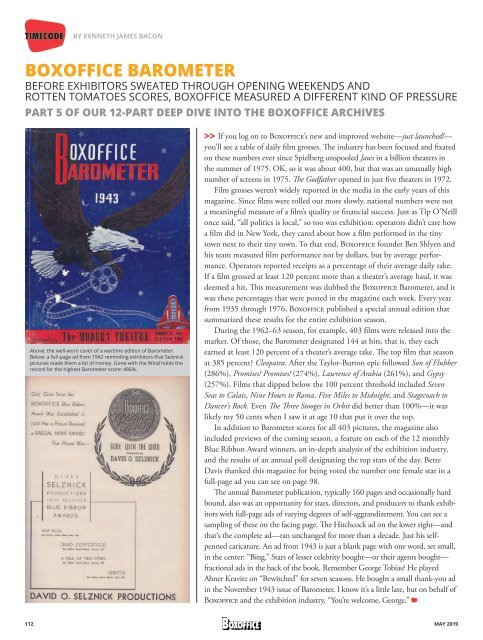Boxoffice - May 2019
The Official Magazine of the National Association of Theatre Owners
The Official Magazine of the National Association of Theatre Owners
Create successful ePaper yourself
Turn your PDF publications into a flip-book with our unique Google optimized e-Paper software.
TIMECODE<br />
BY KENNETH JAMES BACON<br />
BOXOFFICE BAROMETER<br />
BEFORE EXHIBITORS SWEATED THROUGH OPENING WEEKENDS AND<br />
ROTTEN TOMATOES SCORES, BOXOFFICE MEASURED A DIFFERENT KIND OF PRESSURE<br />
PART 5 OF OUR 12-PART DEEP DIVE INTO THE BOXOFFICE ARCHIVES<br />
Above: the well-worn cover of a wartime edition of Barometer.<br />
Below: a full-page ad from 1942 reminding exhibitors that Selznick<br />
pictures made them a lot of money. Gone with the Wind holds the<br />
record for the highest Barometer score: 486%.<br />
>> If you log on to <strong>Boxoffice</strong>’s new and improved website—just launched!—<br />
you’ll see a table of daily film grosses. The industry has been focused and fixated<br />
on these numbers ever since Spielberg unspooled Jaws in a billion theaters in<br />
the summer of 1975. OK, so it was about 400, but that was an unusually high<br />
number of screens in 1975. The Godfather opened in just five theaters in 1972.<br />
Film grosses weren’t widely reported in the media in the early years of this<br />
magazine. Since films were rolled out more slowly, national numbers were not<br />
a meaningful measure of a film’s quality or financial success. Just as Tip O’Neill<br />
once said, “all politics is local,” so too was exhibition: operators didn’t care how<br />
a film did in New York, they cared about how a film performed in the tiny<br />
town next to their tiny town. To that end, <strong>Boxoffice</strong> founder Ben Shlyen and<br />
his team measured film performance not by dollars, but by average performance.<br />
Operators reported receipts as a percentage of their average daily take.<br />
If a film grossed at least 120 percent more than a theater’s average haul, it was<br />
deemed a hit. This measurement was dubbed the <strong>Boxoffice</strong> Barometer, and it<br />
was these percentages that were posted in the magazine each week. Every year<br />
from 1935 through 1976, <strong>Boxoffice</strong> published a special annual edition that<br />
summarized these results for the entire exhibition season.<br />
During the 1962–63 season, for example, 403 films were released into the<br />
market. Of those, the Barometer designated 144 as hits, that is, they each<br />
earned at least 120 percent of a theater’s average take. The top film that season<br />
at 385 percent? Cleopatra. After the Taylor-Burton epic followed Son of Flubber<br />
(286%), Promises! Promises! (274%), Lawrence of Arabia (261%), and Gypsy<br />
(257%). Films that dipped below the 100 percent threshold included Seven<br />
Seas to Calais, Nine Hours to Rama, Five Miles to Midnight, and Stagecoach to<br />
Dancer’s Rock. Even The Three Stooges in Orbit did better than 100%—it was<br />
likely my 50 cents when I saw it at age 10 that put it over the top.<br />
In addition to Barometer scores for all 403 pictures, the magazine also<br />
included previews of the coming season, a feature on each of the 12 monthly<br />
Blue Ribbon Award winners, an in-depth analysis of the exhibition industry,<br />
and the results of an annual poll designating the top stars of the day. Bette<br />
Davis thanked this magazine for being voted the number one female star in a<br />
full-page ad you can see on page 98.<br />
The annual Barometer publication, typically 160 pages and occasionally hard<br />
bound, also was an opportunity for stars, directors, and producers to thank exhibitors<br />
with full-page ads of varying degrees of self-aggrandizement. You can see a<br />
sampling of these on the facing page. The Hitchcock ad on the lower right—and<br />
that‘s the complete ad—ran unchanged for more than a decade. Just his selfpenned<br />
caricature. An ad from 1943 is just a blank page with one word, set small,<br />
in the center: “Bing.” Stars of lesser celebrity bought—or their agents bought—<br />
fractional ads in the back of the book. Remember George Tobias? He played<br />
Abner Kravitz on “Bewitched” for seven seasons. He bought a small thank-you ad<br />
in the November 1943 issue of Barometer. I know it’s a little late, but on behalf of<br />
<strong>Boxoffice</strong> and the exhibition industry, “You’re welcome, George.”<br />
112 MAY <strong>2019</strong>

















